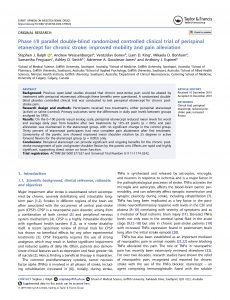
Gold Coast, Australia (January 2020): The results of a Griffith University randomized, placebo-controlled, double-blind clinical trial of PSE were published today, confirming the efficacy and remarkable results of PSE in a cohort of stroke survivors with relentless, intractable daily pain after stroke. The individuals were treated an average of about 4 years after stroke and each reported constant daily pain after their stroke that had failed to adequately respond to all previous forms of treatment. They received two doses of PSE, each two weeks apart, with the control group receiving two doses of saline administered perispinally. The control group had no change in their daily pain, but the treatment group had a significant reduction in pain, measured at 30 days, with 30% of the treatment patients showing near complete pain abatement after the first PSE treatment. The study concludes: “PSE can provide significant and ongoing benefits for the chronic post-stroke management of pain and greater shoulder flexion by the paretic arm. Effects are rapid and highly significant, supporting direct action on brain function.” The PSE stroke treatment was invented by Edward Tobinick, M.D., Director of the Institute of Neurological Recovery in Boca Raton, Florida. Dr. Tobinick was instrumental in the design of the University clinical trial.
Lead investigator Associate Professor Stephen Ralph from Griffith’s School of Medical Science said the findings from the peer-reviewed, double-blinded, placebo controlled, randomized clinical trial were unprecedented in terms of beneficial improvements that were provided in recovery of participants from stroke-related disability and a ‘game-changer’ for medicine.
“These findings support the published observations from animal models of stroke, prior case studies and open-label/observational studies on over a thousand stroke patients reported previously,” he said.
The results have been published in the journal Expert Opinion on Investigational Drugs.
A detailed analysis of the clinical trials results and scientific/medical significance have been published on February 6, 2020 in the journal Expert Review of NeurotherapeuticsF
Background Information
The following peer-reviewed scientific publications provide background information:
- Randomized clinical trial validating the use of PSE to reduce post-stroke disability has wide-ranging implications. Ian A Clark, Expert Review of Neuroatherapeutics, February 6, 2020, https://doi.org/10.1080/14737175.2020.1727742. (Free Download).
- Phase I/II parallel double-blind randomized controlled clinical trial of PSE for chronic stroke: improved mobility and pain alleviation. S. J. Ralph, et.al., Expert Opin Investig Drugs, 2020: p. 1-16.
- Immediate Resolution of Hemispatial Neglect and Central Post-Stroke Pain After PSE: Case Report. Edward Tobinick MD, Clinical Drug Investigation, 2019 Oct 22, epub, (Free Download).
- PSE advances as a neurotherapeutic. Edward Tobinick MD, Expert Review Neurotherapeutics, 2018:1-3. (Free Download).
- PSE for Traumatic Brain Injury. Edward Tobinick MD, Kinssies R, Kim N, et.al. Chapter 7, pp. 109-29, in New Therapeutics for Traumatic Brain Injury, KA Heidenreich, editor. Cambridge, Mass.: Academic Press. 2017. (Link to Book Chapter).
- On Overcoming Barriers to Application of Neuroinflammation Research. Edward Tobinick MD, Ignatowski, T., Spengler, R. In: Abreu GEA, ed. Mechanisms of Neuroinflammation: InTechOpen; 2017. (Free Download).
- Perispinal Delivery of CNS Drugs. Edward Tobinick MD. CNS Drugs, 2016;30(6):469-80. (Free Download).
- Authors’ Reply … PSE for Post-Stroke Neurological and Cognitive Dysfunction: Scientific Rationale and Current Evidence. Ignatowski TA, Spengler RN, Tobinick E. CNS Drugs, December 2014, 28(12):1207-13. (Free Download).
- PSE for Post-Stroke Neurological and Cognitive Dysfunction: Scientific Rationale and Current Evidence. Ignatowski TA, Spengler RN, Dhandapani KM, Folkersma H, Butterworth RF, Tobinick E. CNS Drugs, August 2014, 28(8):679-697, published online 27 May 2014. (Free Download).
- Immediate Neurological Recovery Following PSE Years After Brain Injury. Edward Tobinick MD, Rodriguez-Romanacce H, Levine A, Ignatowski TA, Spengler RN. Clin Drug Investig. 2014 May;34(5):361-6. (Link to Journal Article).
- Studies of Selective TNF Inhibitors in the Treatment of Brain Injury From Stroke and Trauma: A Review of Evidence to Date. Tuttolomondo, A., R. Pecoraro, and A. Pinto, Drug Design, Development and Therapy, 2014(November). 8: p. 2221-2239. (Free Download).
- New Hope for Survivors of Stroke and Traumatic Brain Injury. Clark, I., CNS Drugs, 2012. 26(12): p. 1071-2; (Free Download).
- Selective TNF Inhibition for Chronic Stroke and Traumatic Brain Injury – An Observational Study Involving 629 Consecutive Patients Treated with PSE. Edward Tobinick MD, Kim NM, Reyzin G, et. al. CNS Drugs. 2012 Dec;26(12):1051-70. (Link to Journal Article).
- Rapid Improvement of Chronic Stroke Deficits After PSE: Three Consecutive Cases. Edward Tobinick MD. CNS Drugs. 2011 Feb 1; 25(2):145-155. (Link to Journal Article).
- PSE: A New Therapeutic Paradigm in Neurology. Edward Tobinick MD. Expert Review of Neurotherapeutics. 2010 Jun;10(6):985-1002. (Free Download).
- PSE for neuroinflammatory disorders. Edward Tobinick MD. Drug Discovery Today. 2009 Feb;14(3-4):168-77. (Full Text Link).
- Rapid intracerebroventricular delivery of Cu-DOTA-etanercept after peripheral administration demonstrated by PET imaging. Edward Tobinick MD, K Chen PhD, X Chen PhD. BMC Res Notes. 2009 Feb 27;2:28. (Free Download).
- Paths to acceptance. The advancement of scientific knowledge is an uphill struggle against ‘accepted wisdom’. Wolinsky H. EMBO Rep. 2008 May;9(5):416-8. (Free Full Text).

